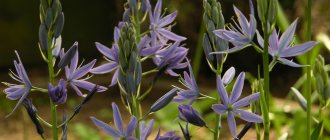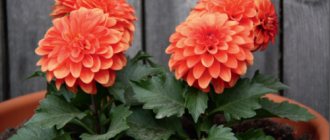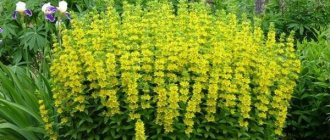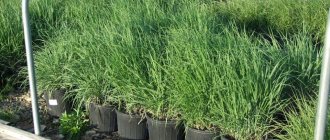Common yarrow is a perennial herbaceous plant used for medicinal purposes against inflammation, and also as a means to stop bleeding. Inflorescences found their purpose back in the Stone Age.
In common parlance this herb is called reznik. The Latin name for yarrow is "Achillea". The plant was named out of respect for the mythical hero Achilles, who cut grass to heal wounds. Another possible origin is associated with the word “Αχιλλέα”, which is translated from Greek as “thousand” and implies many excisions of the leaves of the plant.
Yarrow
Botanical description
Ornamental yarrow or Achillea is a perennial herbaceous plant of the Asteraceae family.
The height of the stem is 15-100 cm. The leaf blades are serrated and arranged alternately. The color of the stems and leaves is bright green - the plant looks decorative even outside the flowering season. During the flowering period, the bush is covered with small inflorescences collected in corymbs. Their diameter reaches 20 cm. The color is bright: sunny yellow, snow-white, lilac, purple, various shades of pink.
The natural habitat is vast: fields, meadows, steppes, mountain slopes of the temperate zone of the northern hemisphere.
Yarrow has been cultivated for hundreds of years. There are species that have medicinal properties. It is used for landscaping gardens, personal plots, and parks.
Amazing variety of species
Biologists count approximately 150 different varieties of yarrow. Many of them appeared thanks to the painstaking work of breeders. Let's look at the most popular of them.
Snow White Dew Drop
A cute perennial up to 60 cm high appeared relatively recently. Its main advantage is its luxurious white buds. They are collected in compact baskets, which are crowned with slender shoots. Thanks to the simple cultivation of yarrow from the seeds of Terry Dew Drop, many summer residents have started such a flower.
In order for the crop to appear in the flowerbed as early as possible, the seeds are sown in late February or early March.
To do this, use containers filled with fertile soil and perform simple operations:
- make shallow grooves;
- sowing seeds;
- cover them with earth;
- the top layer is slightly compacted;
- irrigate with a spray bottle.
Some gardeners grow yarrow in the garden in a simpler way. They sow seeds directly into open ground. Considering the climatic conditions, this can be done before winter or at the end of April.
For better plant germination, it is advisable to place the seeds in a cold place for stratification.
Attractive looking pearl mussel
The perennial is distinguished by its rhizome, which forms a huge number of shoots.
Thanks to this, it grows quickly, occupying more and more of the flowerbed area. Its erect stems reach 75 cm in height. The surface is strewn with small fibers, among which there are narrow leaves in the form of rays. Yarrow buds reach 2 cm in diameter. The petals are painted white. Some varieties of hybrids are distinguished by blue, purple or pinkish hues. In general, the inflorescences are spherical in shape and located at the top of erect shoots. Thanks to the simple cultivation of yarrow Pearl mussel from seeds, the crop is increasingly appearing in flower beds.
The process begins in early spring with the preparation of the substrate. It should contain equal amounts of river sand and fertile soil. Then it is placed in boxes, after which the seeds are sown to a depth of approximately 2 cm. Greenery will appear in 10 days. When it gets stronger, they pick it up, planting it in separate containers.
It is better to water with a liquid sprayer so that the seeds do not accumulate in one area.
Multi-colored paints of the Madison variety
The perennial has a powerful root system and straight stems that grow up to 70 cm. The dense inflorescences of Madison yarrow reach 15 cm in diameter.
The petals are painted in different colors. Flowering occurs in late July or early August. The culture miraculously tolerates dry times and is not afraid of the cold. It is successfully grown in group flower beds of a summer cottage. When dried, the flowers retain the original color of the petals, so they can be used to form winter bouquets.
The many faces of Ptarmika
The variety is characterized by a creeping rhizome, from which shoots grow up to 100 cm high. They are covered with small linear-lanceolate foliage.
During the flowering period, the shoots are crowned with white buds with a pearlescent tint. Yarrow is planted in different ways:
- seeds;
- by dividing the bush;
- cuttings;
- root segments.
Seeds are sown in seedling boxes in the traditional way. To carry out the procedure of dividing the bush, it is dug up along with the roots. Then carefully cut into several pieces. Cuttings are carried out in mid-summer using young shoots. The branches are placed in a solution of a growth stimulator for 12 hours, after which they are planted in the ground. As you can see, planting and caring for Ptarmika yarrow requires special effort from the gardener. However, later the work will bring a lot of joy when cute flowers appear in the garden.
The vibrant splendor of Red Velvet
The plant grows to approximately 80 cm in height. The erect stems are traditionally strewn with many elongated leaves. During flowering, the tops of the shoots are decorated with spherical baskets of bright color. The amazing Red Velvet Yarrow can give your garden a unique look. The main thing is to adhere to proper plant care.
Exquisite Queen of the Flowerbed
The maximum height of the shoots is about 60 cm. During flowering, an abundance of small buds appears on them, collected in dense bouquets.
Terry petals are colored carmine or pink. Yarrow Queen loves open sunny places and grows in any soil. It is propagated by dividing the bush and by seeds. In one area, the variety can grow for up to five years.
Growing decorative yarrow from seeds
Yarrow seeds photo
Remember that seeds collected from hybrid plants do not retain the varietal characteristics of the mother plants. Therefore, you can only sow seed purchased in a specialized store, or seeds from your garden, collected from varietal plants.
Sowing in the ground
How to sow yarrow in the ground photo
- You can sow yarrow seeds in open ground before winter in late autumn.
- The bed is prepared in advance and well leveled so that there are no holes.
- Make small furrows at a distance of 15-20 cm, sow less frequently, preferably at a distance of 4-5 cm.
- The rows are covered with a rake and left until spring, mulching the bed with humus.
- In spring, seedlings are thinned out twice, leaving a final distance of 8-10 cm for low-growing varieties and 20-25 cm for tall ones.
Sowing seedlings
How to grow yarrow seedlings photo
Start sowing yarrow for seedlings at the end of February . Take fertile soil, mix with coarse sand, fill the box with the mixture.
- Sow the seeds in rows, keeping a distance of 3-4 cm.
- Deepen the seeds into the soil 0.5-1 cm.
- Spray the soil with a spray bottle.
- Cover the crops with film, ventilate them daily, and periodically moisten the soil.
- Sprout in a warm place with indirect light.
- Shoots will appear in 10-14 days.
- When 2 true leaves appear, plant them in separate containers (peat pots are ideal).
Reproduction methods
Poreznik is propagated in the following ways:
- seeds;
- dividing the bush;
- cuttings.
In gardening, propagation by cuttings and dividing the bush is most often used. These methods are quite simple, and young seedlings do not require special care.
Seeds
For planting, special planting material of varietal plants should be used. Seeds are sown in mid-autumn in open ground in previously prepared grooves. The distance between seeds should be at least 5 cm.
After planting the seeds, the furrows are filled with substrate and leveled, and the soil is mulched with humus. Shoots that appear in spring should be thinned out, leaving the strongest ones.
Dividing the bush
Once every 3 years, in early spring, an adult specimen is divided. During this period, the bush has time to grow. It is carefully cut into sections with a well-developed root system and planted in a permanent place.
By cuttings
Cuttings are separated in summer. It is important that each cutting has at least three developed buds. The cuttings are planted in nutrient soil and left there until roots appear. When the plant gets stronger, it is transplanted into the soil to a permanent place, where the necessary regular care is provided.
How to care for yarrow in the garden
The combination of decorative yarrow with other flowers in the photo variety Achillea x Pretty Belinda
Yarrow grows best in open areas with bright light. Please note that yarrow can grow aggressively, drowning out neighboring crops.
Where to plant
It is unpretentious to the composition of the soil. Able to grow in depleted, sandy soils, but flowering will be more abundant when grown in nutritious, loose, alkaline soil.
Watering and fertilizing
- If the weather is dry, water once a week. The rest of the time it is content with precipitation.
- Does not require private feeding. Twice a season, feed with complex mineral fertilizer (in early spring before flowering and during flowering).
- It is not recommended to feed with organic matter.
Sanitary pruning and grass collection
Remove faded flowers regularly. This promotes the emergence of new ones and also protects against unwanted self-seeding.
The collection of inflorescences for further use for medicinal purposes is carried out right during flowering. Cut them, dry them, store them in a paper envelope.
In autumn, trim the shoots, leaving a length of 10-15 cm. The plant is cold-resistant, but if a cold winter is expected, mulch the soil with dry leaves.
Transfer
Every 5 years the plant should be replanted and the bush divided.
Diseases and pests
Decorative yarrow is resistant to diseases and pests. Occasionally it is affected by the striped weevil (larvae settle in the roots, adult insects eat the leaves). The soil should be treated with hexachlorane, and the above-ground part with chlorophos.
Features of cultivation
Soil selection
Cut grass can grow in low-nutrient substrates, but in order for it to feel comfortable and bloom for a long time, preference should be given to fertile and loose soil, which allows air to pass through well and prevents moisture stagnation at the rhizome.
A fine-grained base combined with river sand is more suitable as a soil than others. Such soil will promote the active growth and development of the cutworm.
Location and lighting
Yarrow prefers sunny places. When planting, gardeners should not forget that the plant grows well, therefore, when choosing a place for cultivation, you should pay attention to large areas warmed by the sun.
Yarrow in the garden
Temperature, humidity, watering
Since poreznik is a drought-resistant plant, it should be irrigated once every 7 days in dry summers. In cold weather, the frequency of watering is halved.
Fertilizers and fertilizers
It is recommended to feed the grass no more than 1-2 times; often it is enough to add mineral fertilizer in the spring and during the flowering period. It is not recommended to use organic substances to feed yarrow.
Transfer
Once every 4-6 years in the spring, the plant needs to be transplanted to a new place. Transplantation is carried out by dividing the bush. Old specimens are uprooted, separated and strong roots are planted, from which strong young shoots will grow over time.
Trimming and collecting grass
At the end of flowering, the inflorescences are cut off. This allows you to increase the decorative properties of the plant and prevents the yarrow from growing too much. With the onset of cold weather, shoots must be cut to 15 cm.
During the collection of grass, parts from flowering specimens are cut off. It is recommended to cut off parts up to 15 cm in length. Before drying, cut off the scutes and separate them from the peduncles. Dry the grass in the air in the shade or in attics.
Wintering
Planted plants tolerate cold periods well. Already in May, the bushes of cut grass grow and become lush. There is no need to cover yarrow for winter, with the exception of young plants. You can cover the bush with fallen dry leaves.
Types of yarrow with photos and names
Yarrow lewisii variety King Edward Achillea x lewisii 'King Edward' photo
There are more than 150 plant species; let’s look at the most popular ones in gardening.
Achillea nobilis
Yarrow Achillea nobilis photo
The shoots reach a height of 0.5 m. The flowers are white with a yellow core. Blooms in early summer.
Silver yarrow Achillea clavennae
Silver yarrow Achillea clavennae photo
The height of the stem is 25 cm, the inflorescences are snow-white. The leaves are silvery-silky-hairy, pinnate, cut into several lobes, alternating, about 4-8 centimeters. This plant blooms profusely from June to August.
Achillea millefolium
Achillea millefolium photo
Inflorescences appear in mid-summer and last about 1.5 months. Color white, yellow, pink, purple.
Decorative pink yarrow Variety Achillea x millefolium 'Apple Blossom' photo
Multi-colored varieties look very beautiful in single plantings and are attractive in mixed combinations.
Yarrow ptarmica or pearl oyster Achillea ptarmica
Yarrow ptarmica or pearl oyster Achillea ptarmica photo
The compact bush reaches a height of 1 m. The leaves are small, oblong in shape. The reed inflorescences are arranged in several rows, forming a ball shape, and are painted white with a pearlescent tint. Blooms for a couple of months.
Achillea ptarmicoides
Achillea ptarmicoides photo
The leaf blades and stems are grayish in color. Flowering in June. The core of the flowers is cream-colored, the reed inflorescences are white.
Achillea filipendulina
Yarrow Achillea filipendulina variety Cloth of Gold photo
Reaches a height of 1.2 m. Flowers in July-August. Golden inflorescences.
Achillea tomentosa
Felted yarrow Achillea tomentosa variety Goldie photo in the garden
Reaches a height of no more than 15 cm, grows 45 cm wide. It blooms in August. Yellow inflorescences.
Keller's yarrow Achillea x kellereri
Keller's yarrow Achillea x kellereri photo
The height of the bush is 15 cm. The flowers are snow-white.
Achillea ageratifolia
Achillea ageratifolia photo in the garden
The height is 15-20 cm. The leaves are oblong and pubescent. Single baskets reach a diameter of 2.5 cm, the reed petals are snow-white.
Yarrow collection
It is necessary to collect yarrow grass during its flowering period. The fact is that at this time the plant has the most powerful healing properties, and the largest amount of essential oil accumulates in the upper part of the bush. A cloudless and dry day is suitable for collecting grass, and the dew should completely evaporate from the foliage. To cut grass, you can use pruning shears, a sickle, or a very sharp knife; when collecting a very large amount of raw material, you can use a scythe. Only the top part of the bush, about 0.2 m long, should be cut off. Rough shoots that have no foliage are not used as medicinal raw materials. If you want to collect yarrow again next season, then you cannot tear out the bushes along with the roots.
The prepared raw materials for drying should be placed in a clean and dry room, and it can also be placed in the fresh air under a canopy. It should be noted that during drying the grass should not be exposed to direct rays of the sun, because they contribute to the destruction of essential oils and chlorophyll in the prepared raw materials. It should be distributed in a thin layer, and the grass must be systematically turned over while drying, this will prevent it from starting to rot. Also, if desired, you can make bunches of grass that are hung under the roof to dry. When it dries, you should cut off all the stems. You can tell that yarrow has dried out because its shoots easily break off, and its foliage and inflorescences crumble. Only leaf blades, flowers and shoots, the length of which should not exceed 15 centimeters, should be removed for storage. All thick shoots must be cut off and discarded. The finished raw material has a very strong aroma, while it has a slightly bitter taste. For storage, such medicinal herbs are poured into canvas bags, paper bags, cardboard boxes or glass jars, which are stored in a cool, dry and dark place. The herb retains its healing properties for 2 years. If the container is very well sealed, the raw materials can be stored for up to 5 years.
Decorative yarrow in landscape design
Yarrow is decorative throughout the season: in early spring, greenery appears that does not fade even with the onset of cold weather; in summer, the bushes are abundantly covered with bright inflorescences.
Yarrow in a mixborder photo of flowers
Plant yarrows in groups, combining different color shades. The combination with veronicastrum, crocosmia, ratibida, and zinnias will be beautiful.
Achillea ageratifolia photo with other flowers
Low-growing varieties can be planted as ground cover, edging borders, and decorating lawns and lawns. Tall ones look good in mixborders, alpine slides, and rocky gardens.
How to plant white yarrow photo of flowers in the garden
Ornamental grasses and plants with silver-colored leaves (gray speedwell, wormwood) will be good neighbors.
Yarrow combination with other flowers photo
Combines with carnation, bluebells, lavender, ajuga, catnip, sage, buzulnik, liatris, foxglove, vich, garden roses, delphinium.
Basic rules for crop care
As you know, yarrow is an unpretentious plant.
That's why busy people love to grow it. However, some rules should be taken into account:
- watering is carried out once a week;
- all faded buds are carefully removed to preserve the decorative appearance of the variety;
- fertilizing is carried out 1 or 2 times throughout the entire season;
- In late autumn, the shoots are cut off, leaving shoots of about 15 cm.
In regions with cold winters, the rhizomes are covered with dry fallen leaves.
As you can see, planting and caring for decorative yarrow does not take much time. In addition, the culture fits wonderfully into the landscape of the summer cottage. It is planted in company with delphiniums, fragrant sage and delicate lilies. Varieties with a bright red color fit wonderfully into alpine hills or rockeries. In a word, yarrow in landscape design takes its rightful place among noble plants.
Garden decoration garden yarrow - video
The best varieties of decorative yarrow with photos and names
Decorative yarrow variety Achillea 'Salmon Beauty' photo
Decorative yarrow variety Achillea 'Royal Tapestry' photo
Decorative yarrow variety Achillea x millefolium 'Red Velvet'
Decorative yarrow variety Achillea x millefolium 'Anthea' photo
Yarrow decorative variety Paprika Achillea x millefolium 'Paprika' photo
Siberian yarrow variety Achillea sibirica 'Love Parade' photo
Yarrow garden variety Achillea millefolium 'Summer Pastels' photo
Garden yarrow varieties 'Moonshine' and 'Coronation Gold' photo in a flower bed
Yarrow garden variety Achillea millefolium 'Rose Madder' photo
Other uses
In addition to its decorative and healing properties, the Yarrow herb is also used in the following situations directly related to gardening:
- If it is necessary to combat harmful insects, Yarrow can become an indispensable plant, since it produces repellent substances that repel harmful midges, mosquitoes, flies and even ants and aphids;
- Yarrow can become the basis for nutritional feeding of garden plants and even a component of high-quality compost.
Yarrow against aphids
To combat garden aphids, use dried yarrow grass, or rather its ground part. You need to collect and dry raw materials at the beginning of the bush’s flowering. A kilogram of raw materials is poured with two liters of boiling water and steamed in a water bath for at least 40 minutes, after which another 8 liters of water are added and sent to a dark place for two days.
This product is used to spray the foliage and stems of plants affected by aphids - the result is excellent.
Yarrow as a top dressing
The product is prepared as follows: a container with water is filled with freshly harvested (not dried) Yarrow and left until the raw material ferments. As a rule, one, maximum two weeks is enough, depending on the ambient temperature.
This product is good not only for liquid feeding, but also for pest control.
In the first case, the product is diluted with water in proportions of 1/10, in the second, a steeper mixture is made - 1/5.
High quality yarrow compost
Many gardeners describe an interesting feature of the Yarrow herb: it suppresses the proliferation of putrefactive bacteria, and, on the contrary, promotes increased growth and division of bacteria that decompose raw materials when making compost. In addition, compost with the addition of Yarrow will be saturated with potassium compounds, calcium, and sulfur beneficial elements, which the plant is rich in, and this will have a very good effect on the growth of any plant and will even protect it to some extent from pests and diseases.
Yarrow - to help bees
This grass is noted by beekeepers as an excellent honey plant, that is, it is very attractive to bees, the main pollinators of all plants. Therefore, even if you plant only a couple of Yarrow bushes on your site, they will work for the entire site - more bees, better pollination, which means more harvest.
Medicinal properties of yarrow and recipes based on it
Almost all pharmaceutical preparations that improve digestion contain, to one degree or another, the flowers and leaves of Yarrow. But this is not all the healing capabilities of the plant. It is often used to prepare painkillers, sedatives, hemostatic and anti-inflammatory drugs.
Fresh leaves of Yarrow are rich in essential - volatile phytoncides, which purify the air from harmful microflora, and extracts are made from dry leaves that inhibit staphylococci and streptococci.
An extract from yarrow baskets, in combination with lemon balm, hawthorn and motherwort, has properties that help get rid of angina pectoris, cardiac neuroses and restores the exhausted nervous system.
Yarrow is also used as part of medicinal preparations that cure enuresis and a wide range of diseases of the female genital area.
The use of yarrow in hygienic chemistry
Extracts of this plant are widely used to restore damaged hair. Such problems often arise due to a lack of vitamin A, which Yarrow is rich in. In such a situation, Yarrow extract is what you need. Its use restores dry skin and heals hair, giving it a natural shine.
Here is one recipe for caring for damaged hair. Take 10 grams of dry Yarrow flower and pour a quarter liter of boiling water, then wrap it warmly and leave for an hour. Strain the cooled infusion through cheesecloth and rub two tablespoons at a time into the hair roots, and an hour before washing your hair you need to wet your hair with this infusion.
After washing your hair with shampoo, you should rinse it off and rinse with an infusion diluted in water - 2 tablespoons per liter of water.











